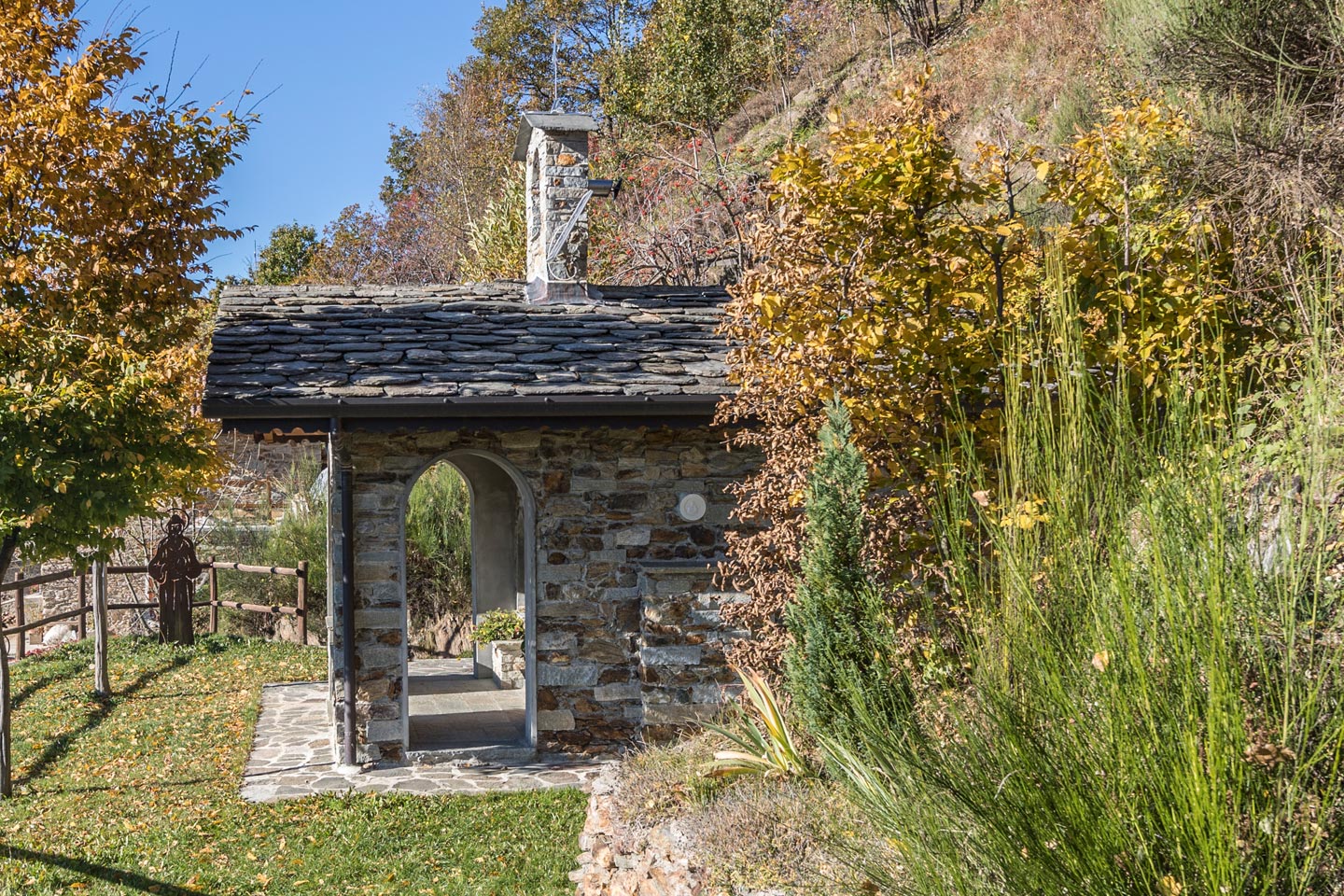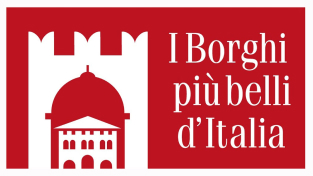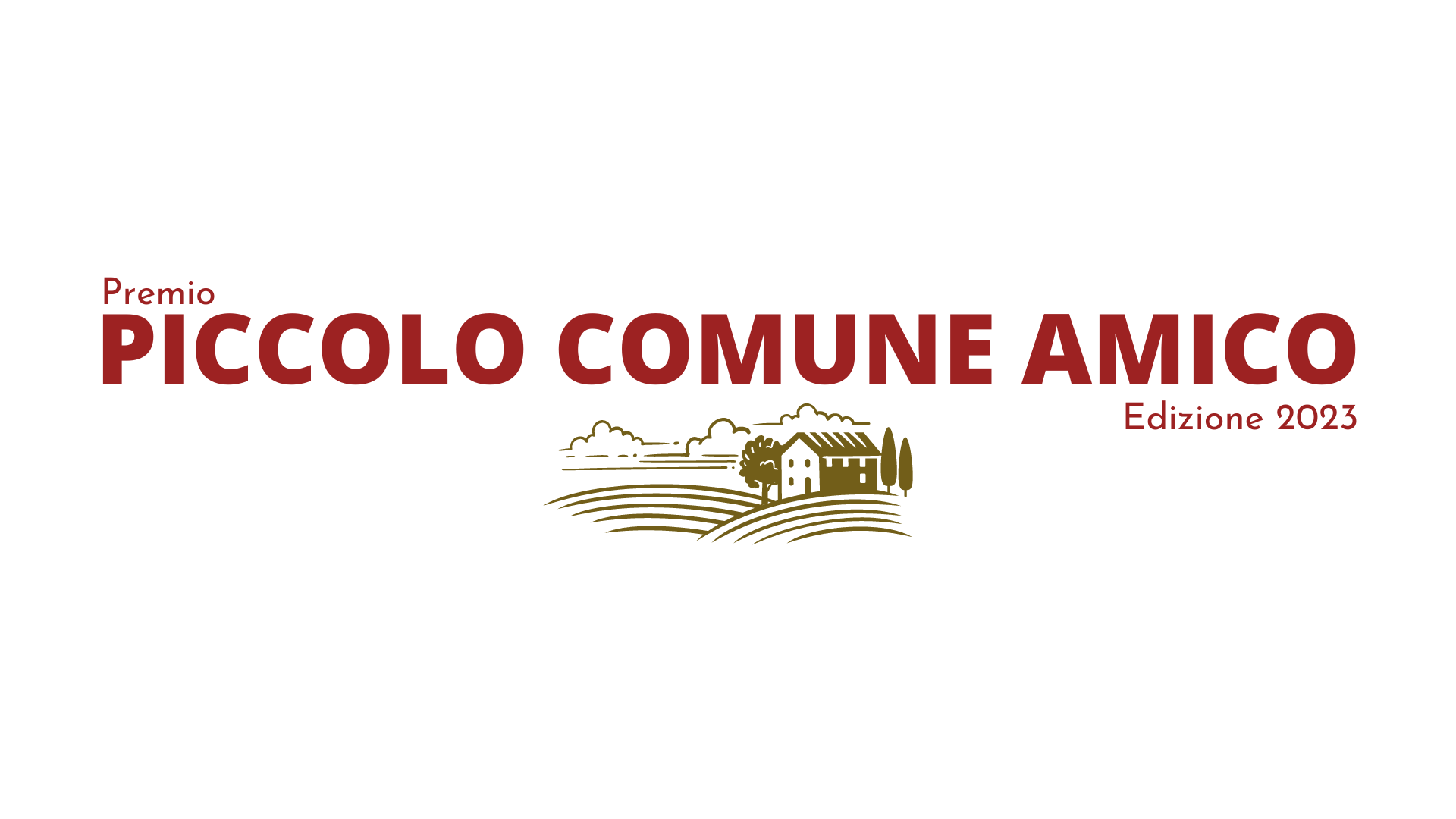This website uses cookies so that we can provide you with the best user experience possible. Cookie information is stored in your browser and performs functions such as recognising you when you return to our website and helping our team to understand which sections of the website you find most interesting and useful.
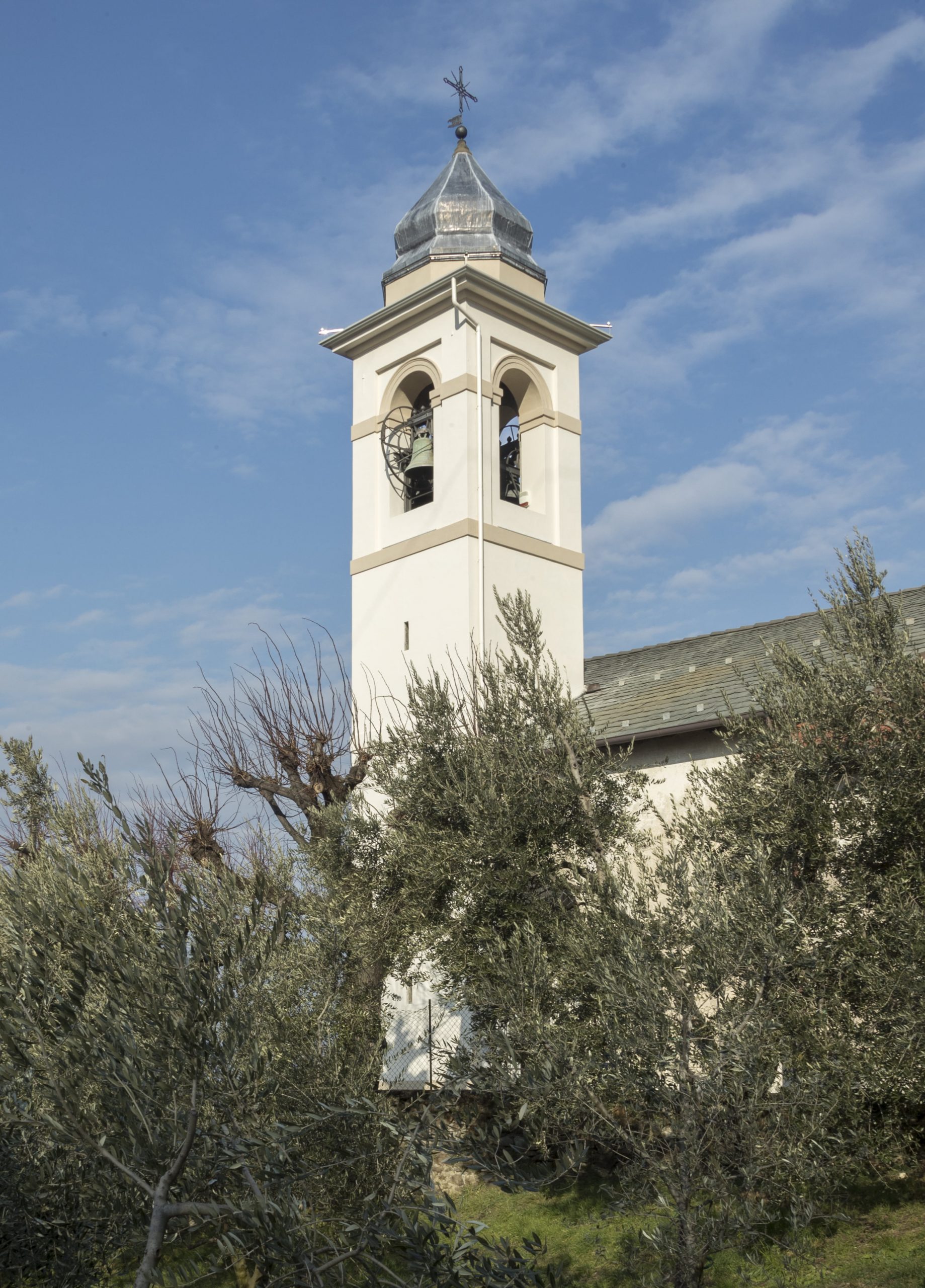
Other churches
San Rocco
The church of San Rocco is located behind the apse of the Prepositural church, in a raised position, near the small Roman bridge over the famous Orrido.
Its construction dates back to 1484 as reported by the engraving on the entrance’s stone architrave, while consecration took place in 1502. In 1587 it became the seat of the Confraternita dei Disciplini o Disciplinati: a group of laymen dedicated to prayer and penance, which was then disbanded in 1786 at the behest of the Austrian government. The hall of said confraternity was on the upper floor, above the current porch, but nothing survives of it except in some prints showing the former appearance of the church front.
In 1968 it underwent major restoration work and today the church is dedicated to the fallen of all wars and is an unusual example of a religious and at the same time civil temple.
The two bombs that precede the portal are very special, as is the collection of flags, documents, land from the battlefields, photos and objects found in the locations of the two World Wars and now displayed in the church. Finally, on the walls of the shrine, the names of Bellano’s fallen are indelibly engraved on stone slabs.
The dedication to Saints Rocco and Sebastian, however, is due to the plague that struck the area and the presence of the Sentiero del Viandante (Wayfarer’s Path) which passes right over the Roman bridge and under the temple’s portico. Churches and chapels dedicated to these saints, in fact, are frequently found along the ancient route.
The interior is simple and consists of a single nave with a slightly raised apse. Worthy of note is the finely worked beam that supports the large triumphal Cross in front of the presbytery, as well as the wooden altar that houses the statues of the Risen Christ and Saints Rocco and Sebastian, all dating back to the seventeenth century; the antependium in San Rocco is from the eighteenth-century. The altarpiece depicting the Madonna and Child with Saints, to whom the church is dedicated, and the fresco in the apse, mentioned in the pastoral visit of 1611, have been lost.
Although more recent, the two large canvases placed at the sides of the altar, by the Bellano painter Giancarlo Vitali, deserve great attention.
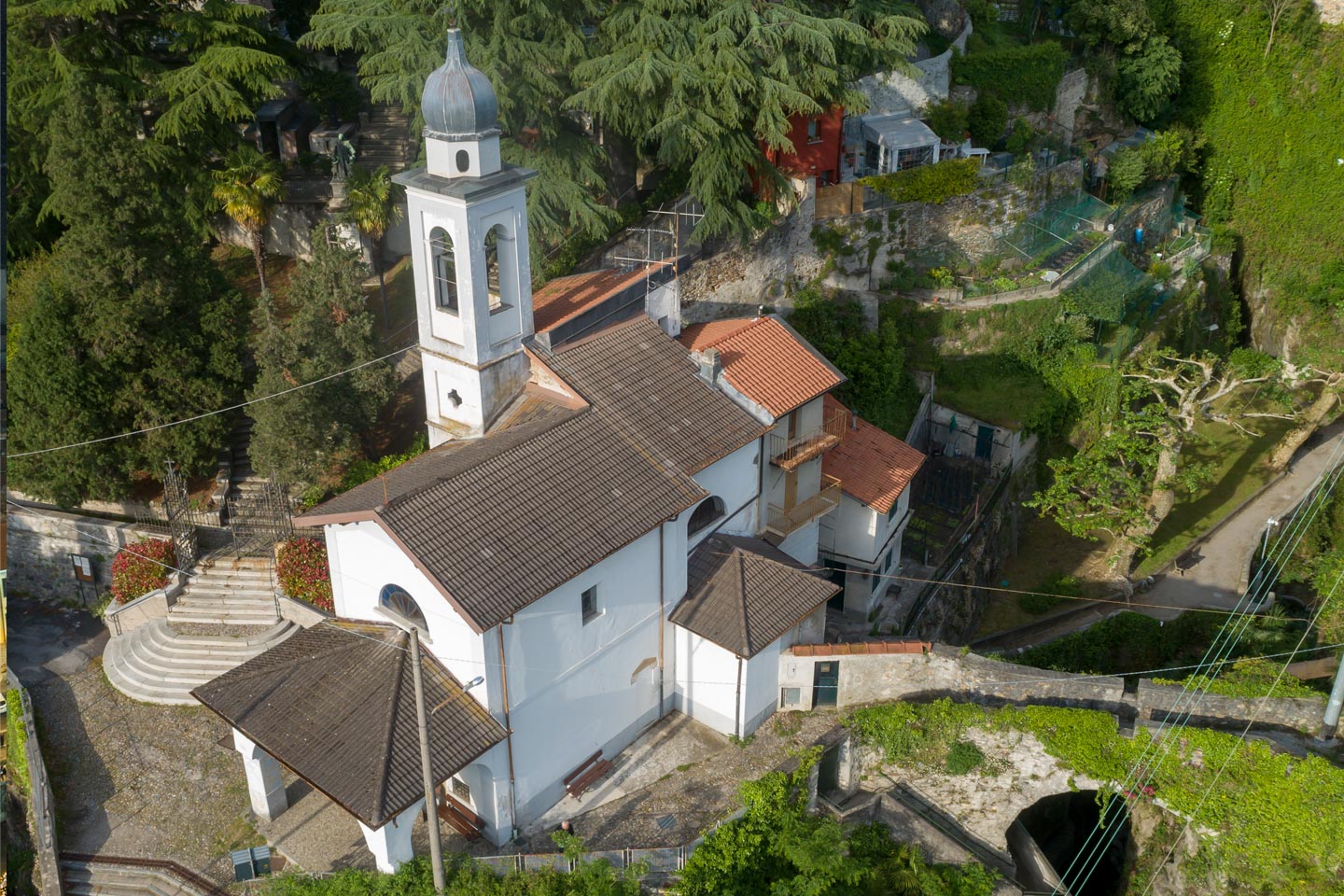
Former church of San Nicolao
The former church of San Nicolao is located on the edge of the historic center and can be reached by following the dense network of “contrade”. It is located at the point where the ancient road to the upper lake and then to Valtellina led into the village’s narrow streets: in that place, this location on the side of the church, was where one of the main gates to Bellano stood, while on the left side there was access to the sacristy and to the small convent that no longer exist.
The dedication to San Nicolao is due to the proximity of the Sentiero del Viandante (Wayfarer’s Path), as in the Alpine area, it was common to find buildings dedicated to the Saint in near the paths or transit routes intended as stations for wayfarers and pilgrims.
The building has suffered many events of both a historical and structural nature. We already know of its existence in 1295, the year in which, for fiscal purposes, a list was drawn up in which the existence of a convent of the Humiliati was mentioned in the place where the temple stands. This religious community prospered for many centuries in Bellano, until its suppression in 1571 ordered by Pope Pius V. From that moment on, the convent passed under the jurisdiction of the “commendatori” and then, at the end of the 18th century, it passed into the hands of private individuals, even though religious functions continued to take place in the church until the middle of the 19th century. After the church was deconsecrated, it became the warehouse of the Gavazzi silk factory, while the rest of the convent was demolished.
The facade with the main entrance and the first section of the church are an addition to the body of the early temple, and probably date back to the sixteenth century. The central part and the one at the rear, consisting of two bays, are not aligned with each other, probably due to the presence of the important road that ran along the south side. The two rooms, added over time by extending the body of the church towards the west, are introduced by a sort of decorated triumphal arch: the presence of frescoes dating back to the late fourteenth century reconfirms the building’s ancient origins, and the decorations on the west wall of the last added body, dating back to the sixteenth century, would tend to confirm that these works were still carried out at the time of the Humiliati, since figures of friars belonging to the Order can still be recognized.
The interior, currently with an exposed roof, was previously subdivided vertically into two floors, while the presbytery, raised by two steps, has retained its valuable brick cross vaulting.
A clearer understanding of the architectural development of the church can be had by analysing the outer part of the south wall, the one bordering the ancient road. This wall, in fact, narrates the succession of different building periods. It is composed of rows of stones and pebbles, mostly in an orderly fashion, interrupted by the insertion, forced and therefore posthumous, of the small portal and the two windows framed by well worked stone ashlars. Although the architectural forms, such as the use of a round arch, are exquisitely Romanesque, the techniques and elements used in the construction of the openings betray the later period in which they were opened.
Internally, although much of the decoration has been lost, some fragments of 14th century frescoes survive.
In the first arch we recognize the Redeemer, six prophets and the Annunciation, inside the niche of the left wall of the second room there is the Agnus Dei and two Saints, in the apse fragments of saints and traces of a large Crucifix. These works are some of the oldest evidence of frescoes in the Province. The grotesques and the two saints in the first room date back to the sixteenth century, while the decorations and portraits in the second are from the seventeenth century. Most of the decorations and the altarpiece mentioned in the pastoral visits that followed on from one another in time, however, have not survived to the present day.
The building is currently owned by the town council and is used for various cultural initiatives.
San Gottardo
San Gottardo is the church in the hamlet of Oro. Built in the sixteenth century, the ancient missal with the annotation of the destruction, in 1341, of the Prepositural church of Santi Nazaro e Celso due to a violent flood of the River Pioverna was found here.
The church of San Gottardo was built between 1569 and 1579 and of the original structure only the spandrel vault of the presbytery has been preserved, while the rest of the building is the result of a 17th century renovation.
The façade is simple, gabled, with a central stone portal surmounted by a large thermal window; on the right side it is flanked by a small building that houses the sacristy on the ground floor and includes a small bell tower. Internally, the nave ends in the presbytery where there is an eighteenth-century altarpiece depicting the Pietà and Saints Gottardo and Benedetto, on the high altar, framed by an aedicule with columns, frieze and marble tympanum, and flanked by two other contemporary paintings depicting Saints Lucia and Caterina da Siena on one side and San Fermo on the other.
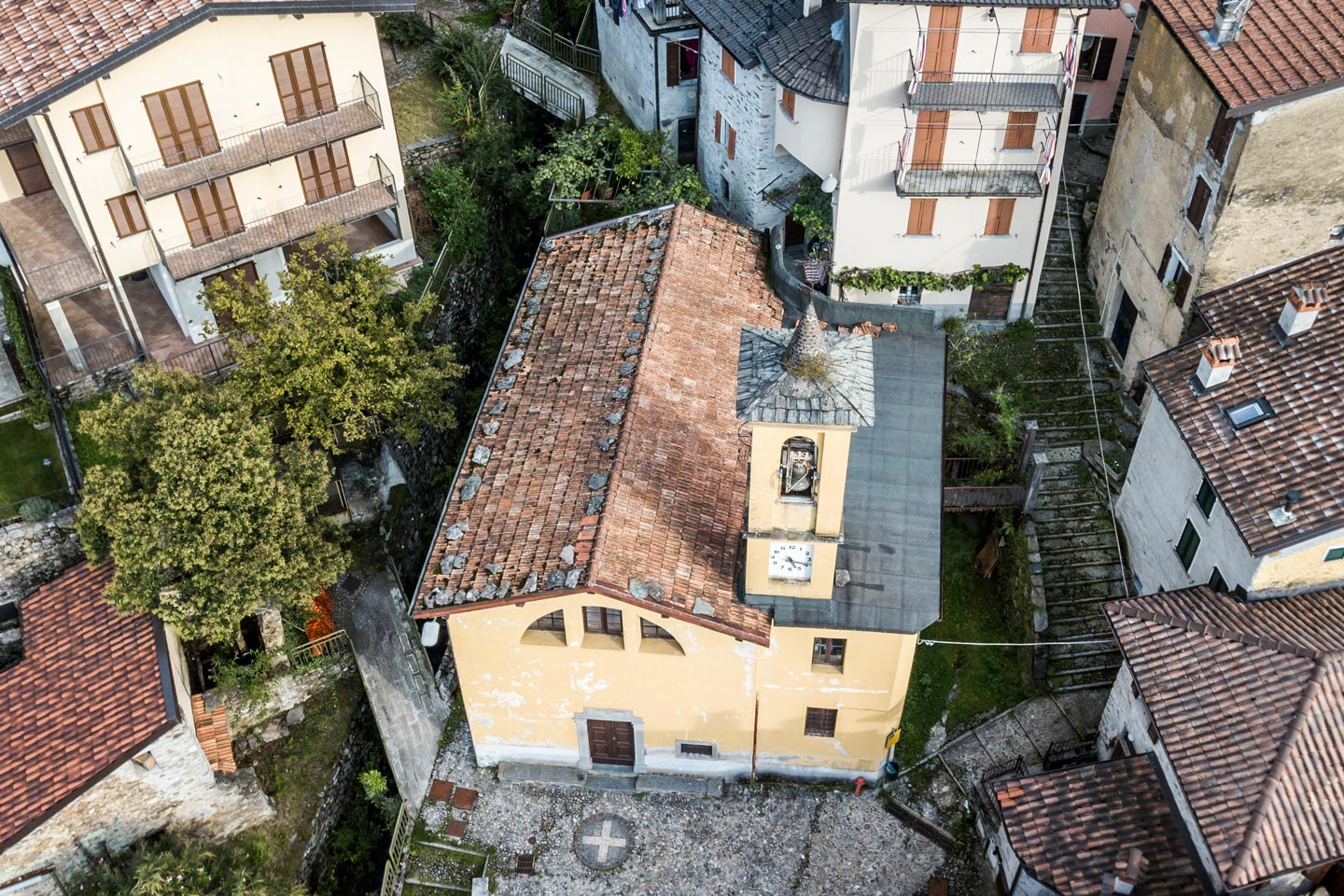
San Domenico
San Domenico is the church of the hamlet of Pendaglio. It was built between 1680 and 1681 with oblations from the inhabitants and still maintains its sober late baroque forms.
It is a very small oratory that enjoys a breathtaking view over the center of the lake.
Externally, the iridescent white façade has a gabled layout with a small bell tower, and two stone benches framing the portal above which two rectangular windows open. The only decoration is a mosaic depicting a cross, made with stones and pebbles.
The interior consists of a single rectangular hall ending in a rectangular apse with a cross vault, preceded by graceful balustrades and a triumphal cross resting on a beam. The altarpiece, dating back to the 17th century, depicts the Madonna of the Rosary with San Domenico.
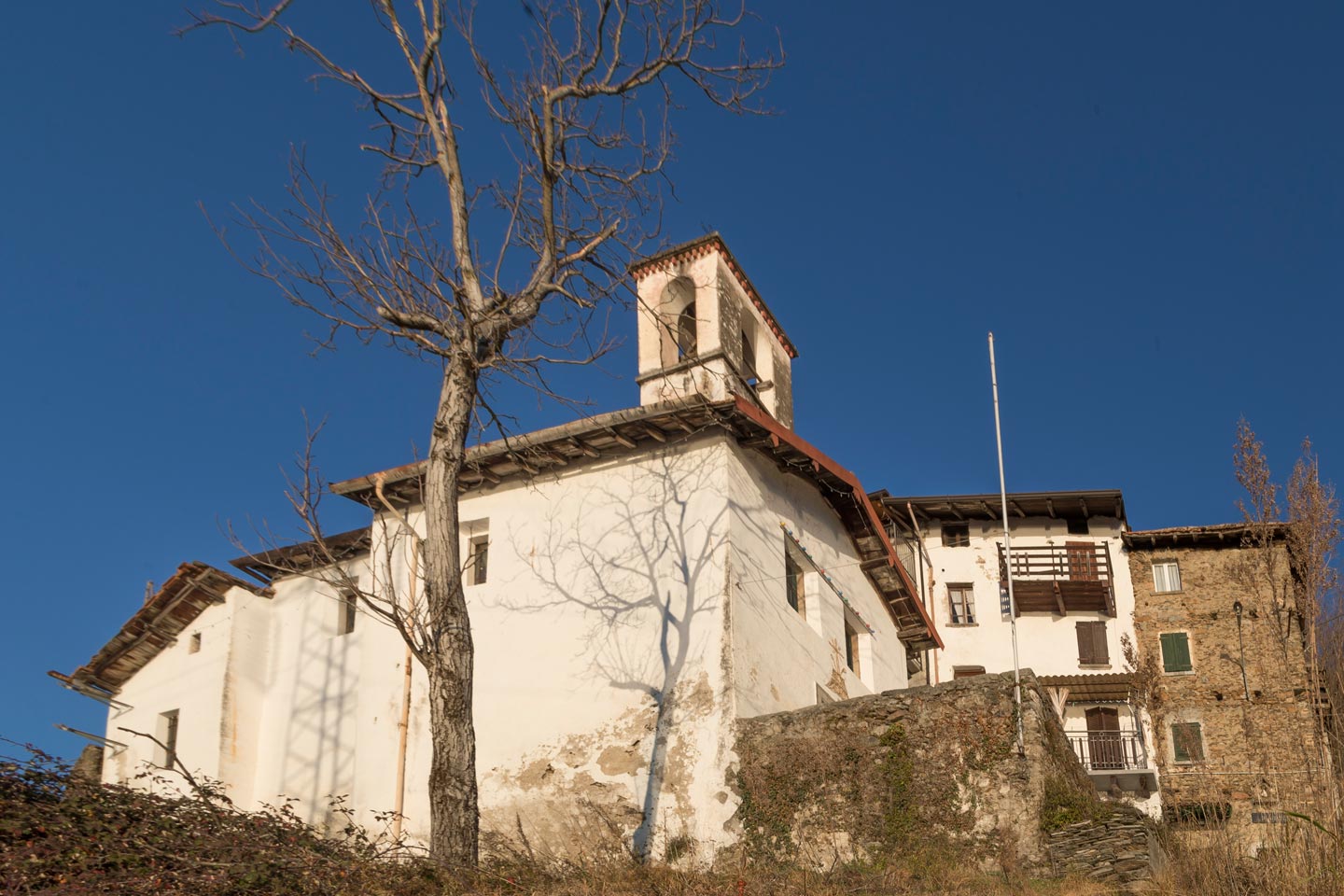
San Carlo Borromeo
San Carlo Borromeo is the church of the hamlet of Pradello. Its construction was completed in 1611 and the dedication to the Saint wass one of the first following his canonization in 1610.
The original structure has undergone enlargements and renovations over time, mostly dating back to the 18th and 19th centuries: the chapel of the Blessed Virgin of the Rosary dates back to 1762 and that of San Grato to 1762. In all probability the church incorporated a previous building, of which a fragment of a fresco depicting a saint remains on the left wall. The façade is simple: flanked by an elegant small bell tower it is framed by two pilasters, with a central stone portal surmounted by a triangular tympanum; a little higher up there is a thermal window. Internally the church is now equipped with three small altars and the plant has a single nave.
In 1997 the church was burgled, with the painting of San Carlo and the decorations that surrounded it and the painting of San Grato placed in the right altar all being stolen. Today the visible works are therefore copies. In the left altar, instead, there is a statue representing St. Antonio Abate.
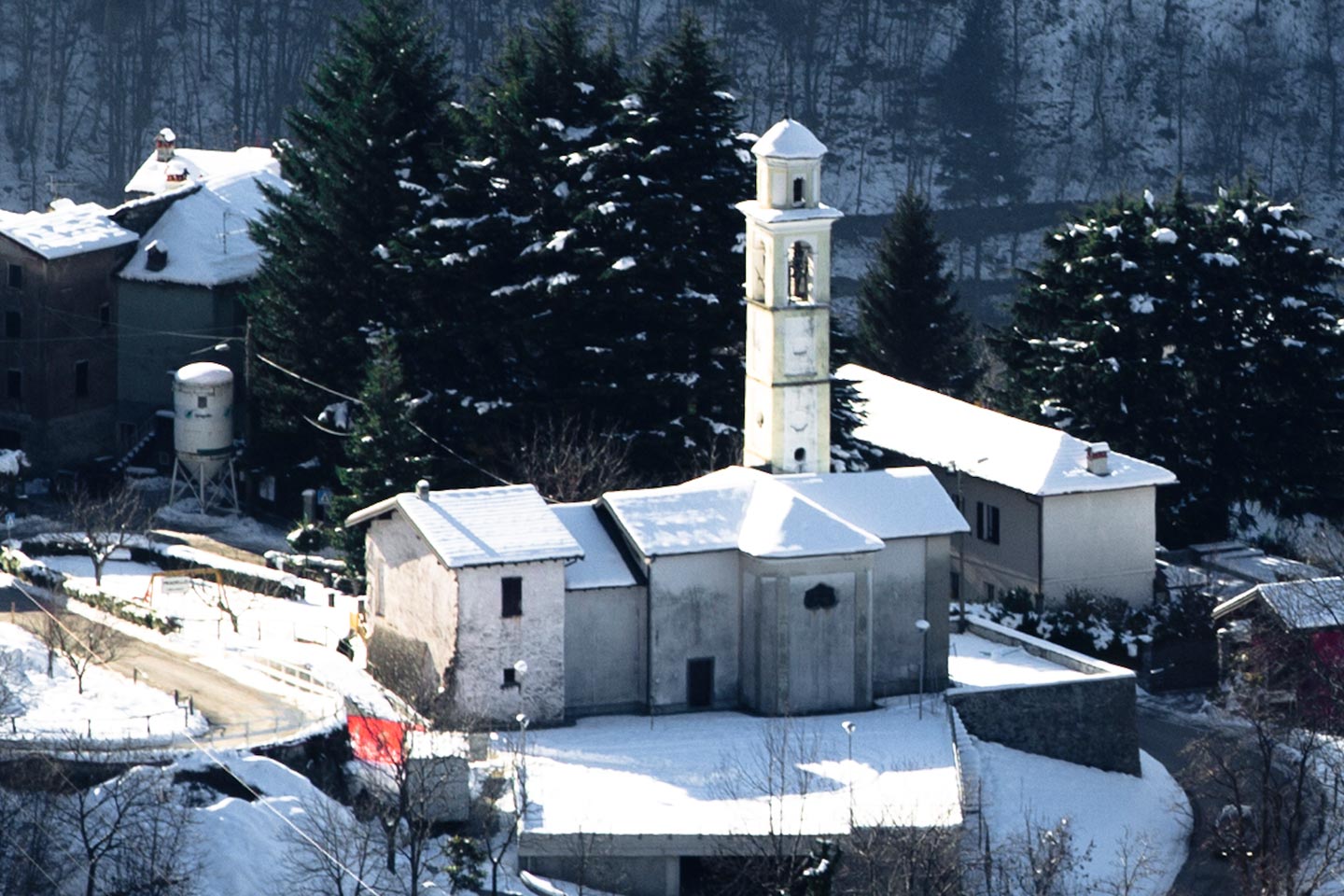
San Bernardino
San Bernardino is the church in the hamlet of Ombriaco. What makes it special, however, is the worship that the inhabitants of the village cedicate to another saint: St. Vincent
Although the oratory was originally dedicated to Bernardino and Sebastian, the painting of the Martyrdom of St. Vincent on the high altar is nowadays the reason for the change of the village’s patron saint. It is said that in 1684 the then provost of Vendrogno commissioned a famous painter from Milan to paint a picture of the Martyrdom of Saint Vincent for the oratory of Inesio. When the painting arrived in Bellano, a group of young people from Vendrognesi came down to go and get it but, when they started to go up the Muggio, it began to snow. Once in Ombriaco, since the path had become impassable, they decided to stop in the village and deposit the painting in the small church to preserve it from the weather, with the hope of being able to resume the journey the next day. The following morning, however, the snow continued to fall heavily, as did the days that followed, and the transport was postponed several times. Every time the young people went to Ombriaco to get the painting, in fact, there was always something that prevented its transport along the mule track. At that point the inhabitants of Ombriaco began to think that the Saint had chosen to remain in their village and therefore asked the provost of Vendrogno to leave the painting in their church. The latter agreed and St. Vincent became the patron saint of the hamlet, relegating Saints Bernardino and Sebastian to being co-patrons.
The small church was built between 1450 and 1455, and underwent some later transformations in the 17th and 19th centuries. The façade is very simple, with a pitched roof. It does not have any kind of decoration; in the middle there is a small portal surmounted by three openings with a serliana scheme. Internally, the temple consists of a baroque-style nave, with a presbytery and a single altar. The altarpiece in the center depicts “The Madonna and Child in Glory and Saints Bernardino of Siena and Sebastiano” from the 17th century, while on a wall of the presbytery there is the painting “The Martyrdom of Saint Vincent” rom the same period.
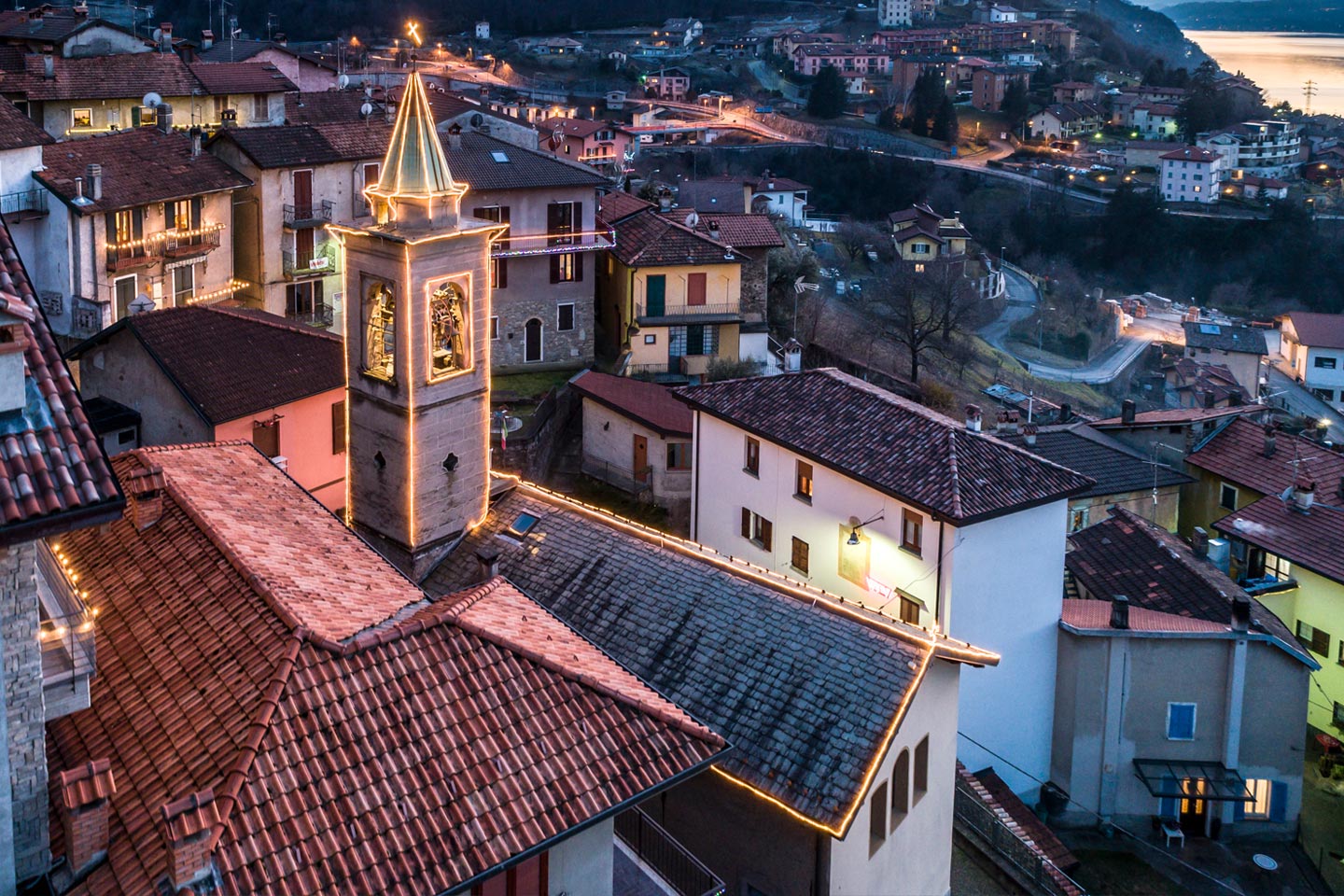
Beata Vergine Maria della Visitazione
Beata Vergine Maria della Visitazione is the church we find in the Bellano hamlet of Pennaso, shared with the church of Portone. The religious building is the link between the two towns, and this is due to the fact that it is located on the ancient road to Valsassina, Val d’Esino and the lake, passing through Bellano: it was in fact necessary to cross that “gateway”, and the term gave its name to the place.
The oratory, with Roman origins, was part of the sighting network of the fortified system of the Lario. Externally it has a facade, attached to another building, rectangular in shape with a stone portal raised four steps flanked by two small windows. Above this opens a rectangular one of larger dimensions in turn surmounted by an opening with more articulated forms. Internally, the church boasts a discreet collection of seventeenth-century paintings: the altarpiece depicts the Madonna and Child with Saint Anthony of Padua, another canvas depicts the Adoration of the Magi, very similar to the one painted in 1609 by Giovanbattista Secchi for the church of San Pietro in Gessate in Milan. The paintings dating back to 1676 depicting Mary scenes are also of interest.
The altar, according to a local story, is the result of a vow made to the Madonna by a traveler who, thanks to her intercession, escaped an ambush by some robbers in the nearby valley.
Oral tradition has it that the inhabitants of the area invoke the Madonna of this little church to ensure refreshing rains during the hottest months.
Sant’Andrea
Sant’Andrea is the church in the hamlet of Bonzeno. Situated on a panoramic hillock overlooking the Coltogno plain and the lake, it can be reached on foot up a flight of steps accompanied by the evocative chapels of the Via Crucis, built in 1907.
There is not much information about its origins, but it is certainly one of the oldest of the oratories dotted around the area. The temple was already present in the 13th century, as attested by an annotation in the Liber Notitiae Sanctorum Mediolani, and there is some information regarding its reconsecration on November 2, 1355, probably following structural reworking. In all likelihood, the complex has undergone four renovations and they concerned the presbyterial area and the nave in the seventeenth century, the high altar built in 1672 and renovated in 1869, the chapel of the Madonna in 1653, the chapel of Sant’Eurosia in 1683 and finally the construction of the small bell tower in 1741 with the chapel of the crucifix a few years later.
Currently the church is in Baroque style, with a very simple facade, in contrast to the richness of the interior.
The first, a hut, is distinguished by the snow-white that makes it clearly visible from the plain below and from the lake. It has a stone portal surmounted by three openings in Serlian style. Inside a valuable life-size crucifix of the thirteenth century is preserved, with the face marked by rigor mortis. The church also has a fresco of the Madonna and Child from the early 16th century, while the frescoes on the left wall have disappeared, torn off in 1653 for the construction of the second chapel.
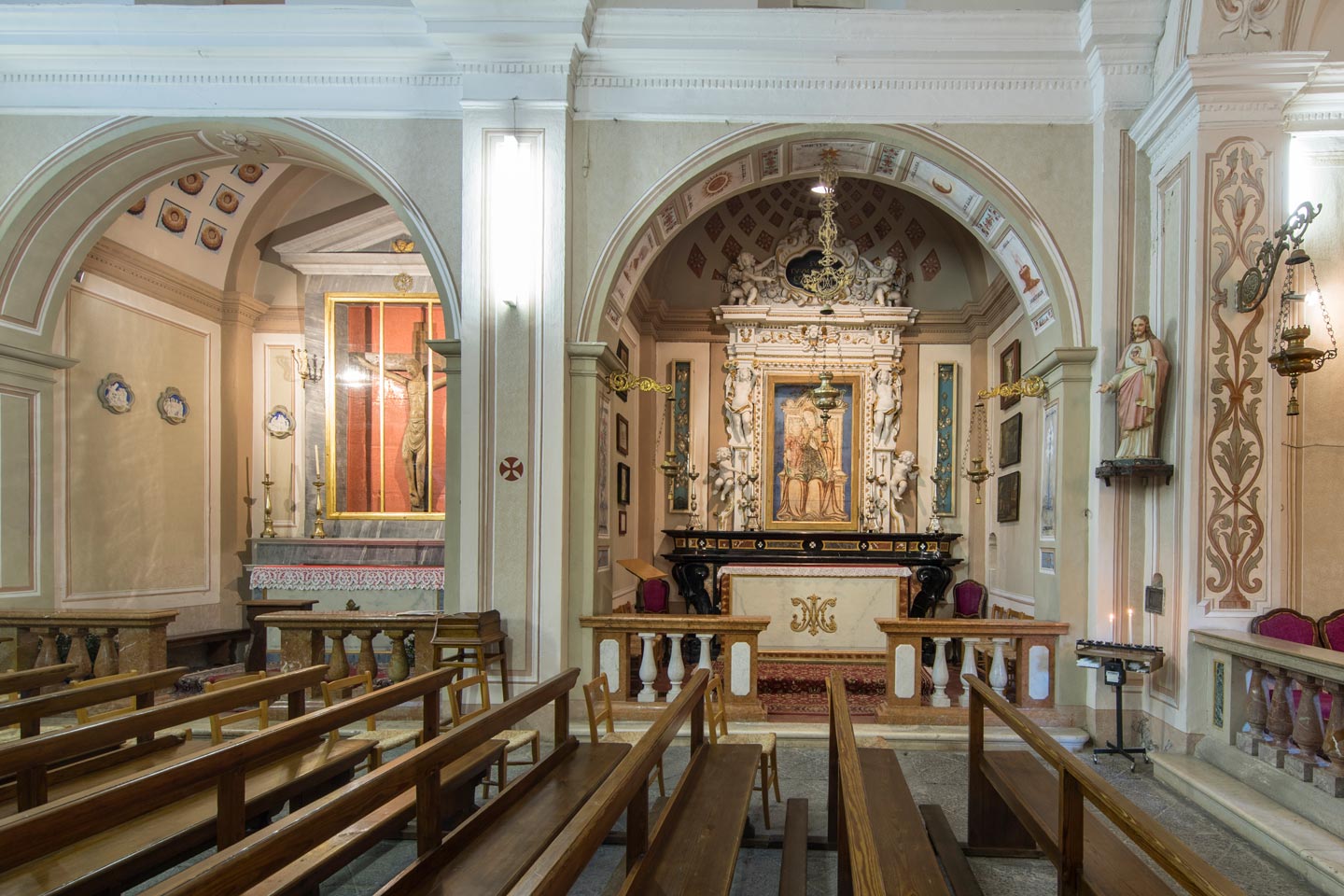
San Francesco da Paola
San Francesco da Paola is the church of the hamlet of Biosio. It was built in the 18th century, after the pastoral visit by the Bishop of Como Feliciano Niguarda, who described the village as follows: “item un miglio sopra Bellano vi è una villetta de fochi 4, senza chiesa, detta Bioggio”.
The oratory is dedicated to Saints Francesco da Paola and Filippo Neri, it has a single hall plant with a raised presbytery and a semicircular apse containing a simple stone altar surmounted by the altarpiece depicting the Apparition of the Madonna by Caravaggio.
Of note are the Baroque balustrades in black and red mirror marble.
Externally the building is very compact, and includes a small bell tower on the left side. The façade is devoid of decorations but is very articulated: tripartite with four pilasters, the most extreme wings bend backwards, giving greater impetus to the central portion with its portal and large window with curved lines and crowned by a particular tympanum with curving shapes.
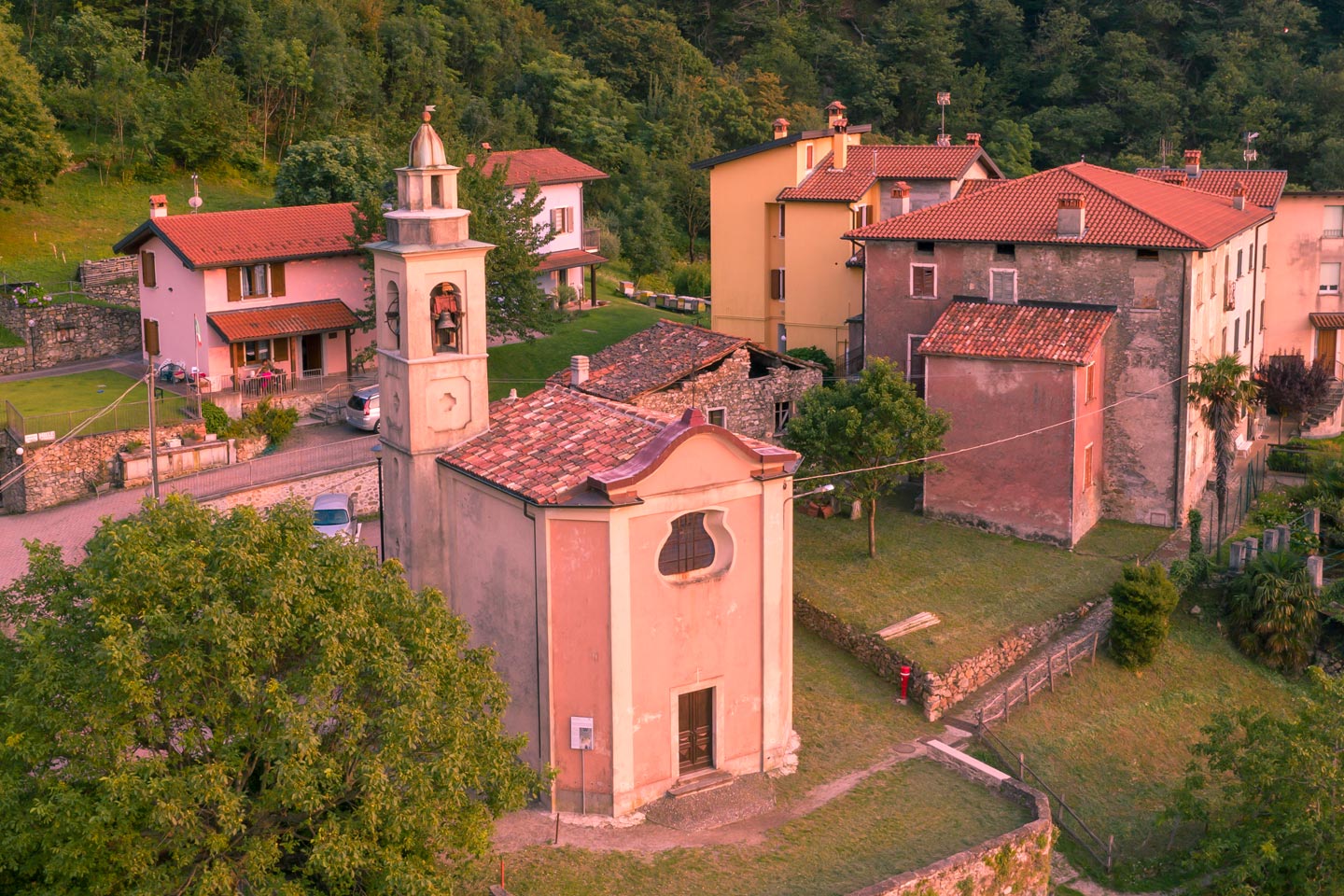
San Gregorio Magno
San Gregorio Magno is the church in the hamlet of Noceno. It was already mentioned at the end of the 13th century in the Liber Notitiae Sanctorum Mediolani by G. da Bussero: “In plebe Belano loco Noxeno ecclesia Sancti Gregorii” is one of the three oldest churches in Muggiasca.
It acquired the title of parish in 1711 following the dismemberment of the territory of the parish church of Muggiasca and kept it until 1986 when, with a greatly reduced population, it returned to its original dependencies.
The original building dates back to the Middle Ages, but there is no evidence of it because, with its expansion in 1736, it underwent numerous changes. The interior, with a single nave, has a cycle of frescoes on the triumphal arch of the presbytery and contains fifteenth-century wooden furnishings, a valuable painting representing San Gregorio Magno with San Lorenzo and San Luigi, a large fourteenth-century processional cross and a chalice of Aostan workmanship dating back to the late Gothic period.
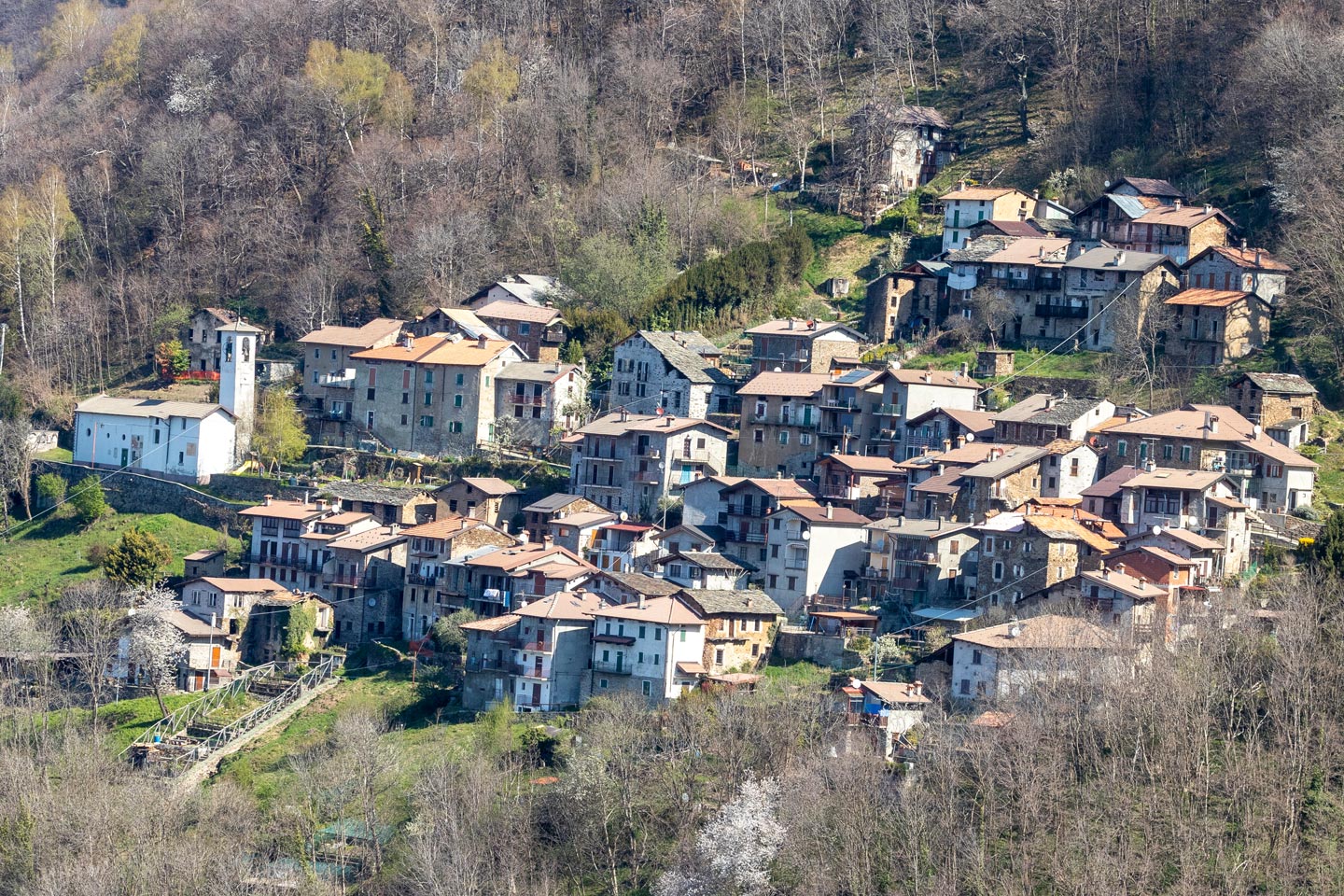
Saint Sebastian
San Sebastiano is the church of the hamlet of Comasira. The primitive structure is datable to the first half of the fifteenth century due to the architectural forms of the small portal, the low roof of the apse with its characteristic barrel vault and the presence of late Gothic frescoes.
The presbytery has a cycle of 16th century frescoes depicting Saints Sebastian and Lawrence, which in turn cover those dating back to the previous century, preserved only in the sacristy and in small portions along the nave and on the triumphal arch.
During the work of moving the altar, a precious reliquary was found walled up inside.
A unique example in the territory of Lecco, a pewter container held a glass ampoule and a gold reliquary worked in damascening with the figures of the crucifixion and Saints Nicholas and Maurice, dating from the late twelfth century. This discovery suggests that the construction of the Gothic temple was based on a pre-existing Romanesque structure, which was probably lost in to a natural disaster. This hypothesis is further reinforced by the oral tradition that explains the isolated position of the church, upstream from the village, since the upper part of the latter was destroyed by a landslide.
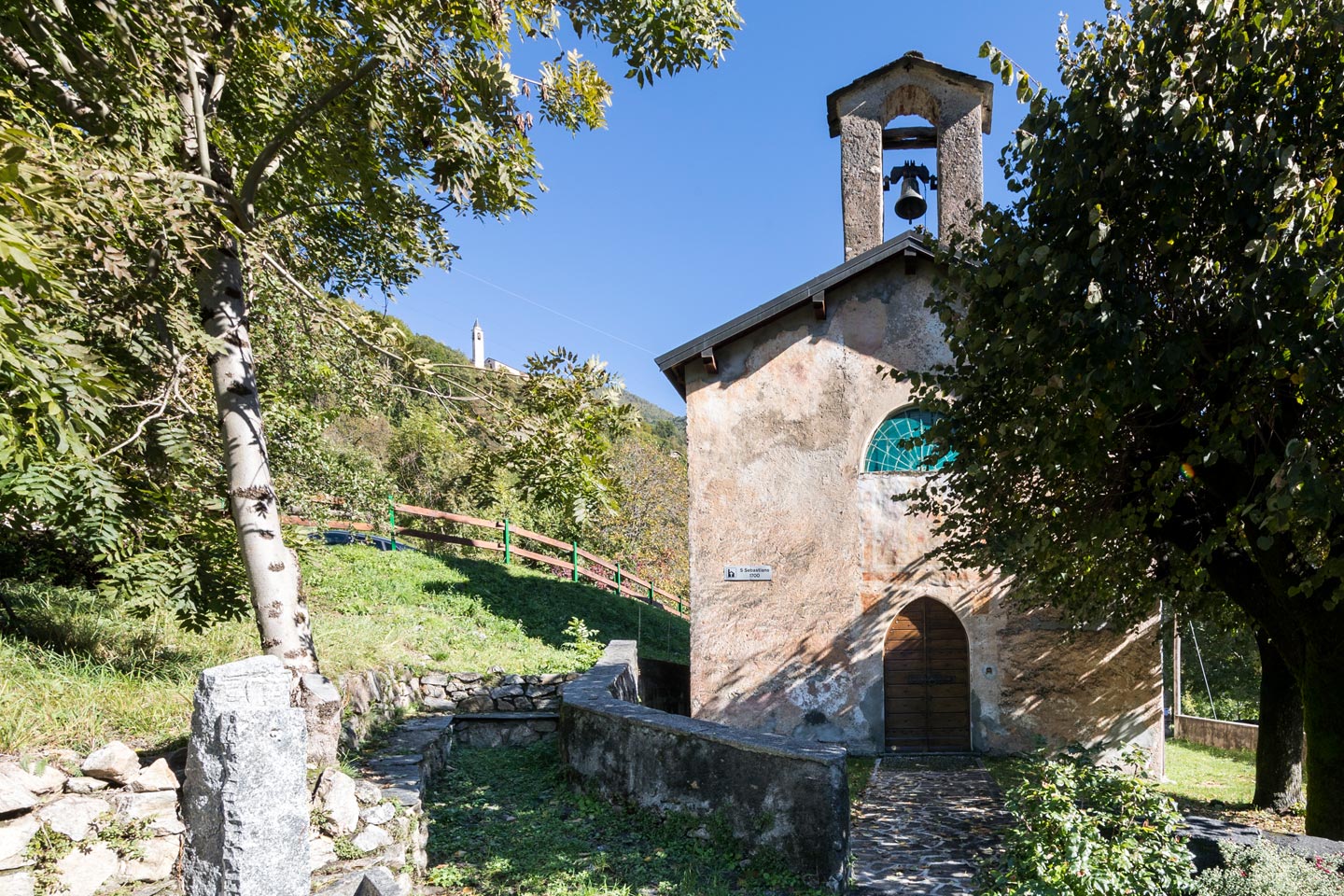
San Antonio Abate
The church dedicated to San Antonio Abate is located in the outermost part of the inhabited center of Vendrogno. From ancient documents it is possible to date the beginning of the construction to 1362 by brothers Antonio and Giulio da Fenile with the authorization of Giovanni de Campazi, provost of Bellano.
The building has a sixteenth-century appearance with alterations attributable to the eighteenth century. The year 1784 is engraved on the entrance portal, a period to which some important renovation works date. The original sail-shaped bell tower was destroyed by lightning in the 1920s and is now replaced by a tower.
The frescoes present both internally and on the façade are of great interest: on the latter, on the sides of the portal and strongly affected by time and bad weather, it is still possible to distinguish the figures of St. Anthony and St. Christopher.
Above the entrance, instead, is represented a Madonna with Child inside the House of Loreto accompanied by the inscription: “GIORGIO DE GILLI DE BRUCA ANNO FATTO FARE QUESTA MADONNA DE LORETO PER SUA DIVOZIONE DIE XXI APRILE MDLXVII”.
Inside the church, however, the 16th century frescoes depict the Deposition (1567) and the life of Jesus (1581) along the right wall, while on the wall facing the altar the Last Judgment is depicted to remind the faithful who leave the church, after the church functions, how important it is to live a righteous life to avoid ending up in hell.
Santa Maria Maddalena
Santa Maria Maddalena is the church in the hamlet of Inesio. There is no certain historical information about this oratory; however, a cartouche painted on the façade states the year 1664, corresponding to the reconstruction work, although it does not specify if these works involved the whole building or only a part of it.
The small church is located in the heart of the hamlet and overlooks the small square that serves as a crossroads for the two ancient mule tracks that connected Bellano with Valsassina and the upper Valvarrone.
Recently restored, the interior houses a beautiful marble altar surmounted by a late 17th century altarpiece framed by stuccoes.

San Rocco
San Rocco is the church in the hamlet of Mosnico.
Probably built in the 16th century east of the hamlet’s center, it contains a valuable statue of San Rocco, protector of travellers and pilgrims, and ancient prints depicting the Via Crucis.
The sacristy is furnished with carved furniture dating back to the 17th century. The rustic facade is composed of natural exposed stones, with the exception of those framing the portal, and is surmounted by a small bell gable.
San Giacomo
San Giacomo is the church in the hamlet of Sanico. Already existing in the 13th century, as reported in the Liber Notitiae Sanctorum Mediolani, it is one of the three oldest churches in Muggiasca and is located at the eastern end of the village, at the entrance of the path to Mornico.
The building underwent a major expansion in the second half of 1753 when it was extended and raised. Some documents dating back to the pastoral visit of 1569 describe the frescoes that decorated the interior walls with the depiction of some scenes of the Passion and Resurrection of Christ, while a very articulated altarpiece decorated the presbytery.
Finally, in the sacristy there was an eighteenth-century portrait of the Blessed Nicolò Rusca, which is now lost.
The facade is very simple and has a stone portal surmounted by a mixed-style tympanum. The interior, with a single nave and two side chapels, still holds an altar with stuccoes of good workmanship, valuable paintings, the altarpiece and the wooden statue of St. James from the eighteenth century.
Starting in 1719, the Confraternity of San Giacomo (St. James) was founded in the church, whose members were mostly emigrants to Venice.
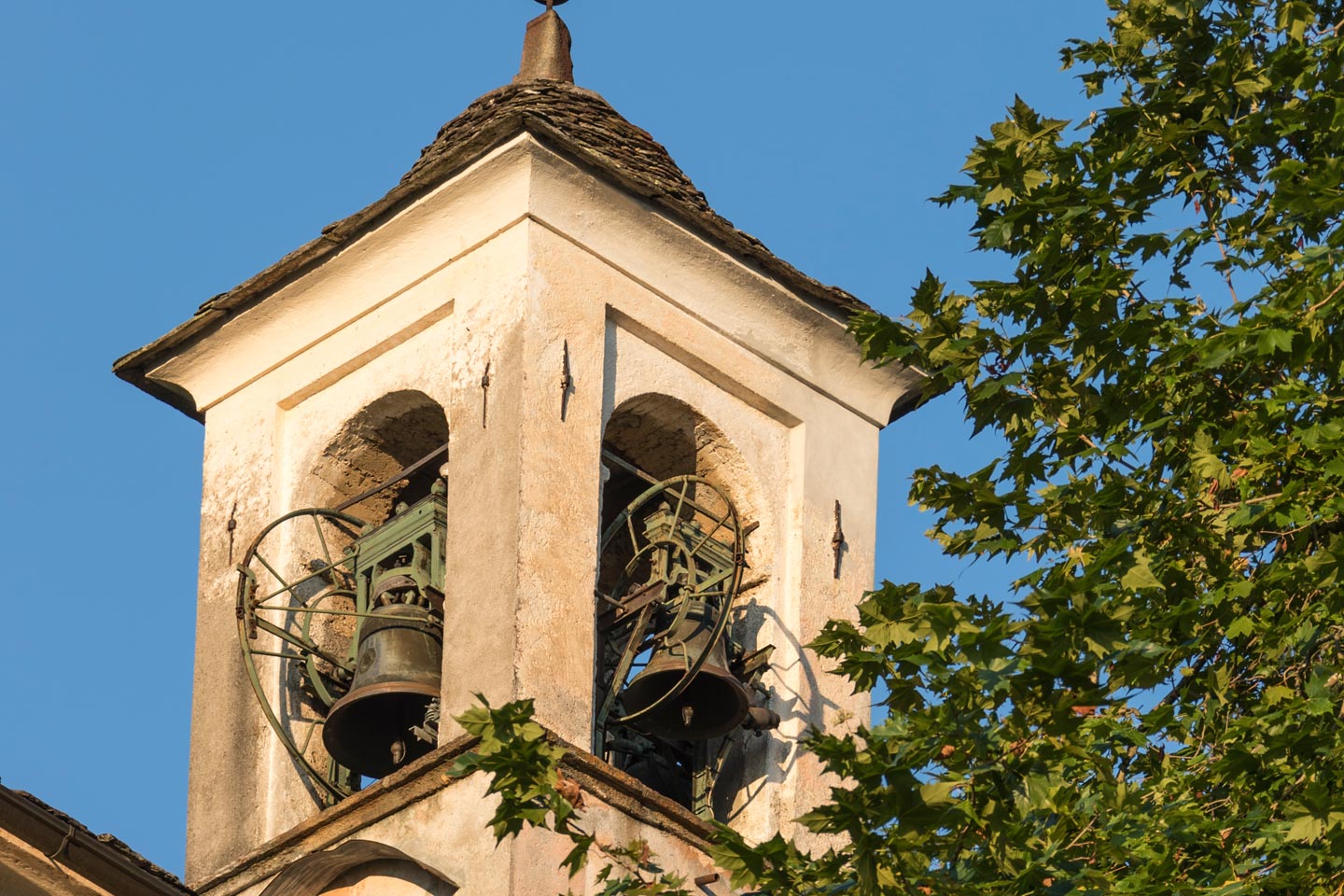
Saint Bernard
San Bernardo is the church in the hamlet of Mornico. Considering its position, outside the town as prescribed by the provisions of San Carlo, it is possible to assume that the church was founded later than the sixteenth century.
Originally dedicated to San Bassiano, bishop of Lodi, it is not known twhen it was given its present dedication, to San Bernardo, abbot of Chiaravalle, although it is certain that this dates back to before 1679 when the inhabitants of the place commissioned the project for the enlargement of the oratory already bearing the new title.
The vaults and the decorations show eighteenth-century features, even if the cross-shaped covering of the presbytery dates back to a few decades earlier. There are valuable paintings including a splendid altarpiece depicting Jesus crucified surrounded by the Madonna, San Carlo and San Sebastiano.
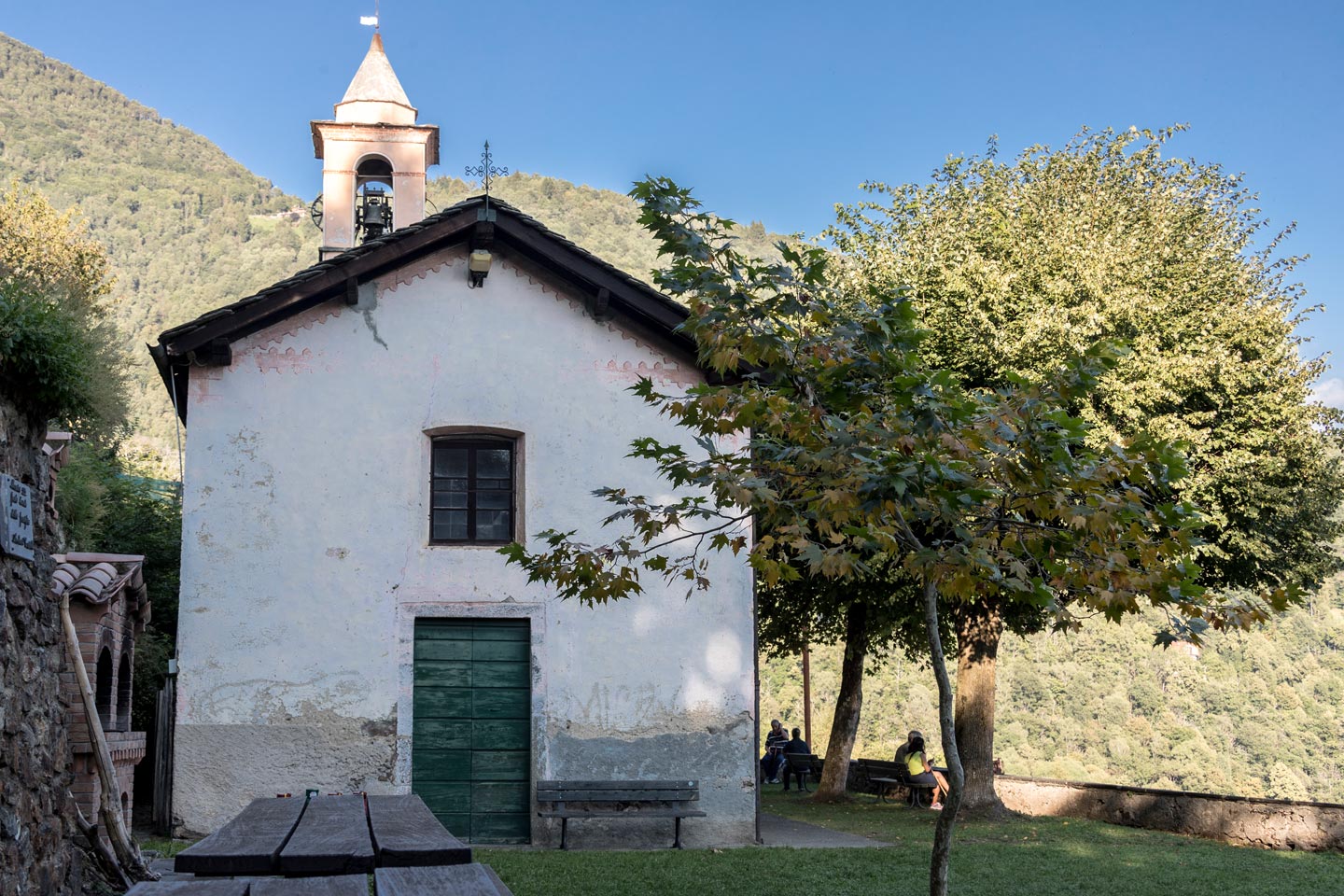
Madonna della Neve
The church dedicated to Our Lady of the Snows, the Santuario della Santa Casa di Loreto, is simply known as “La Madonnina” for the people of Vendrogno. Built in 1630 further to of a vow made by the inhabitants of Vendrogno who had been saved from the scourge of the plague, it is located on the “Zucco” in front of the town center, above an ancient chapel dedicated to the Madonna.
It is a very simple construction, in Baroque style, with a single-nave interior, a presbytery and two side chapels. The façade is simple, with exposed stonework and a stone portal surmounted by three openings that resemble the Serlian style.
Above the portal of the side entrance, however, a plaque recalls the Nazi-Fascist round-up in June 1944, during which all the inhabitants of Vendrogno were locked up in the church, while the military searched the houses for partisans.
On the side of the church there is also a Lourdes Grotto in memory of the miraculously-cured Emma Invernizzi: a twenty-four year old woman from Vendrogno with no hope of life who was taken to Lourdes on a stretcher and came back healed. In December 1932, the President of the Bureau des Constatations de Lourdes recognized this event as miraculous. Finally, near the entrance, there is a column in memory of the vow made by the inhabitants of Vendrogno to escape the plague.
Inside the church there is a wooden statue of the Madonna and valuable paintings among which a Madonna of the milk with Saint Joseph, angel and donor of the 17th century. The high altar is an original and elegant composition of marble and stucco and before it we find an important carved wooden architrave surmounted by a large crucifix.
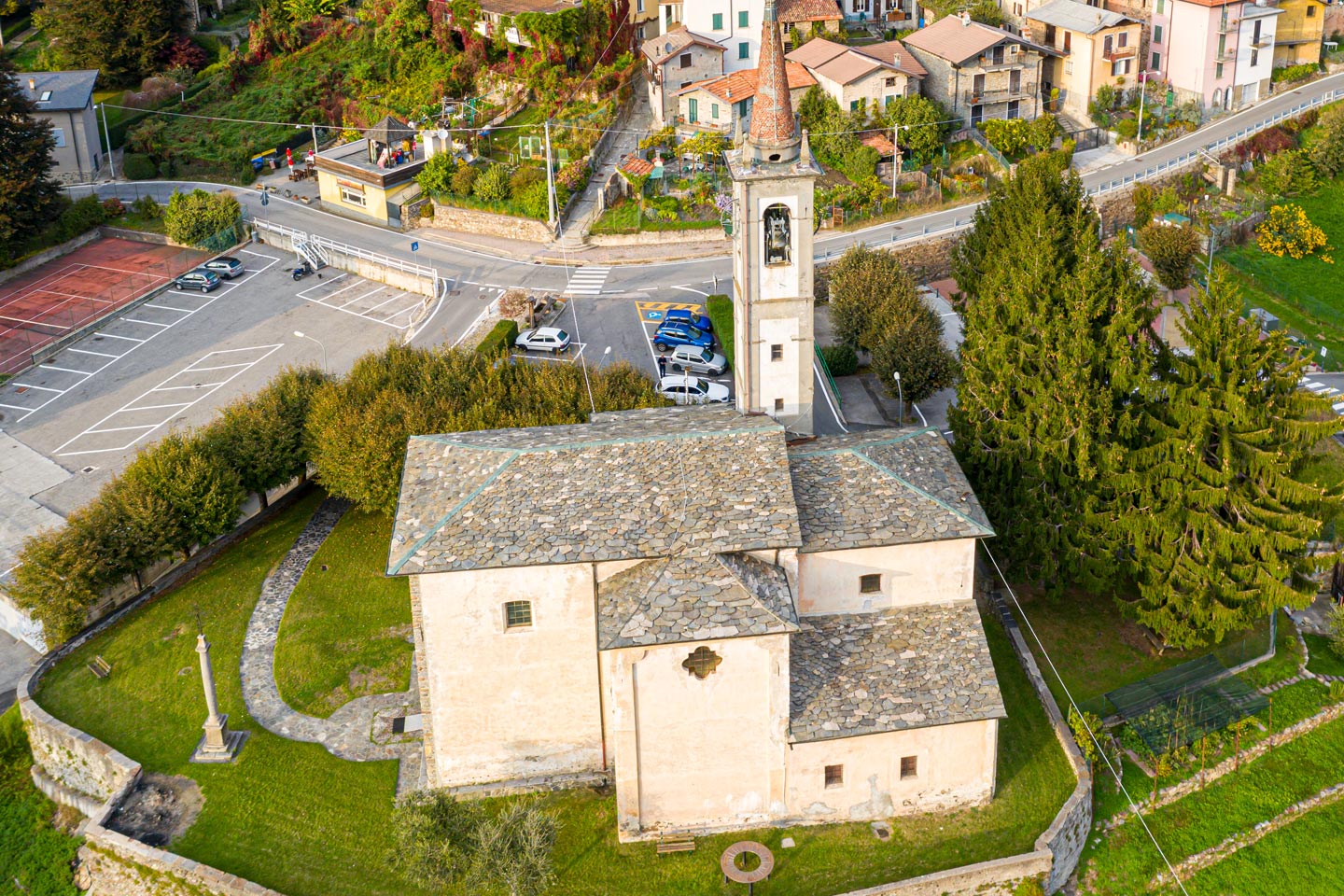
San Grato ai Monti
The small church, dedicated to San Grato, Bishop of Aosta, stands alone on the hill overlooking the lake. It lives on the legend of the hermit brothers of the Lario, being part of the circuit of watchtowers located on the slopes of the mountains overlooking the lake.
The first documented news dates back to 1679, when it was expanded by the architect Giorgio Vitale, a native of Muggiasca, followed by the work to build the altar. In 1692 the sacristy was added, in 1707 the small bell gable was added.
In 1749, finally, a small building was added at the back with the function of hosting pilgrims who came here also from the nearby lands to invoke the Saint for protection on their crops.
In these rooms, since 2000, there has been an exhibition dedicated to the Resistance in Muggiasca; near the entrance, there is a monument in memory of the Partisans who fought on those mountains.
In 1931, during redecoration of the interior by the painter Paolo Vitali of Bellano, a fresco was found that testifies to the antiquity of the church and that was fully restored in the early nineties.
Today, the oratory houses a copy of the wooden statue of San Grato, dating back to the thirteenth century: the original, a work of great value made in Aosta, is kept with the parish church’s treasure.
San Girolamo
San Girolamo Emiliani is the church in the alpine pasture of Camaggiore. It is distant from the town center and enjoys a privileged view of Bellano and Lake Como. This oratory also lives on the legend linked to the hermit brothers since it is part of the Muggio defense circuit.
Its construction dates back to 1893 thanks to the will of the then parish priest of Noceno, on the sport where there was once an ancient chapel dating back to 1500. The dedication is to St Jerome Emiliani, founder of the congregation that took the name of “Padri Somaschi”.
The small church was renovated in 2001 and contains a beautiful wooden statue of St Jerome and a painting donated by an inhabitant of Vendrogno who emigrated to Brazil.
The devotion to St. Jerome Emiliani brings together a lot of people every year on July 20 at the Mass to ensure the suffrage of the Saint against thunderstorms and lightning.
Church to the Fallen for the Homeland
The Chiesetta ai Caduti per la Patria is located in the hamlet of Tedoldo. In 1919 a small pre-existing chapel was rebuilt and dedicated to San Rocco. The building was then enlarged in 1923, the year in which it was decided to dedicate it to Our Lady of the Assumption.
The present appearance and the new dedication are due to the 1976 renovations, as some plaques placed on its facade remind us.
Situated above the alpine pasture, the oratory consists of a double-arched portico which in fact constitutes its façade, with a view of the alpine pasture and the lake and surmounted by a small bell gable. Behind the portico a small room constitutes the church proper.
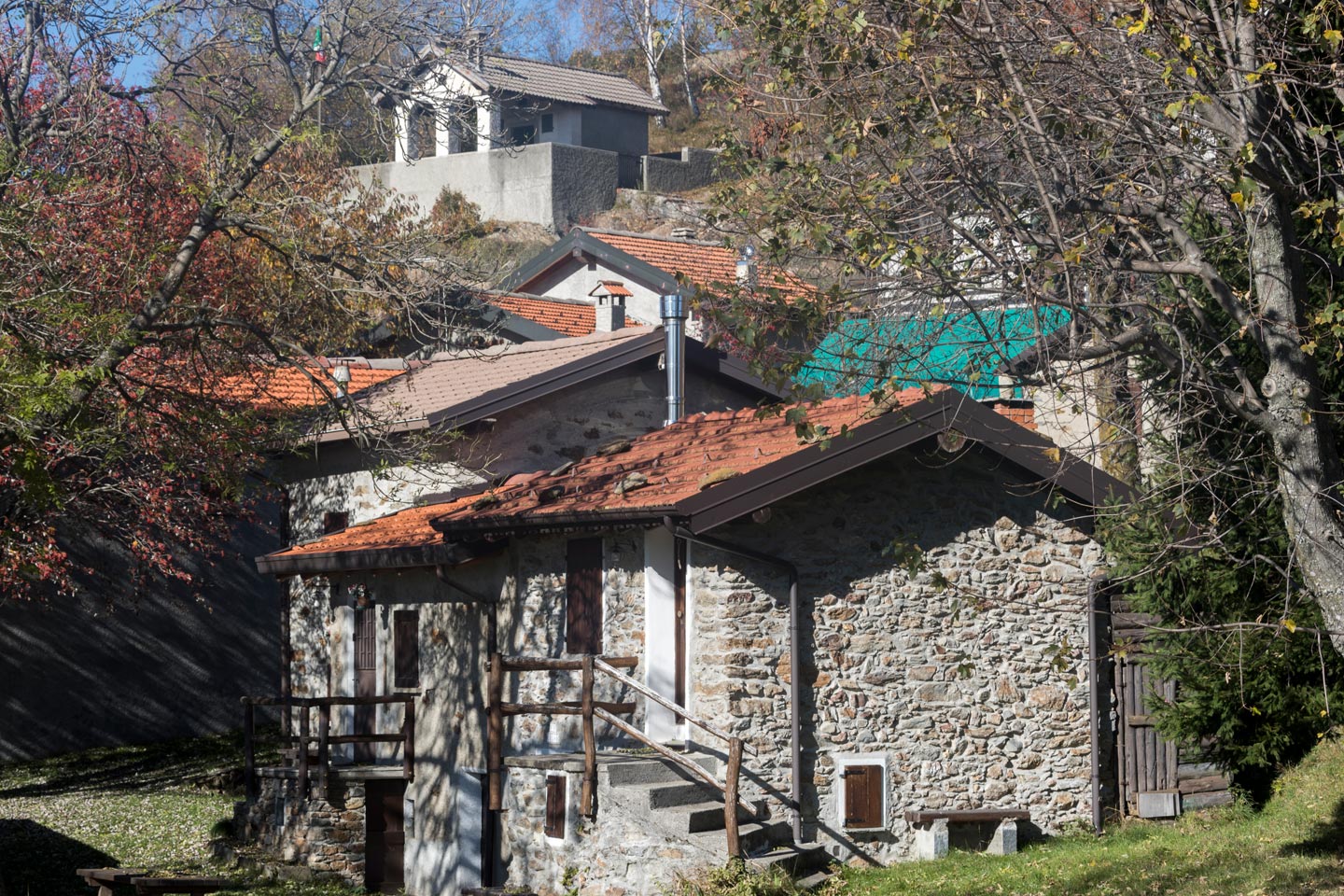
San Charbel
San Charbel is the church in the hamlet of Lornico. It stands in a sunny position, sheltered from the winds over the town center.
Recently built, it was inaugurated in 2011 and dedicated to the Lebanese Saint. Inside there is a fresco depicting the Madonna of Tears of Lezzeno, St. Clare and St. Charbel. The structure is very simple, externally the entrance is preceded by a small porch and on the roof there is a small bell gable.
